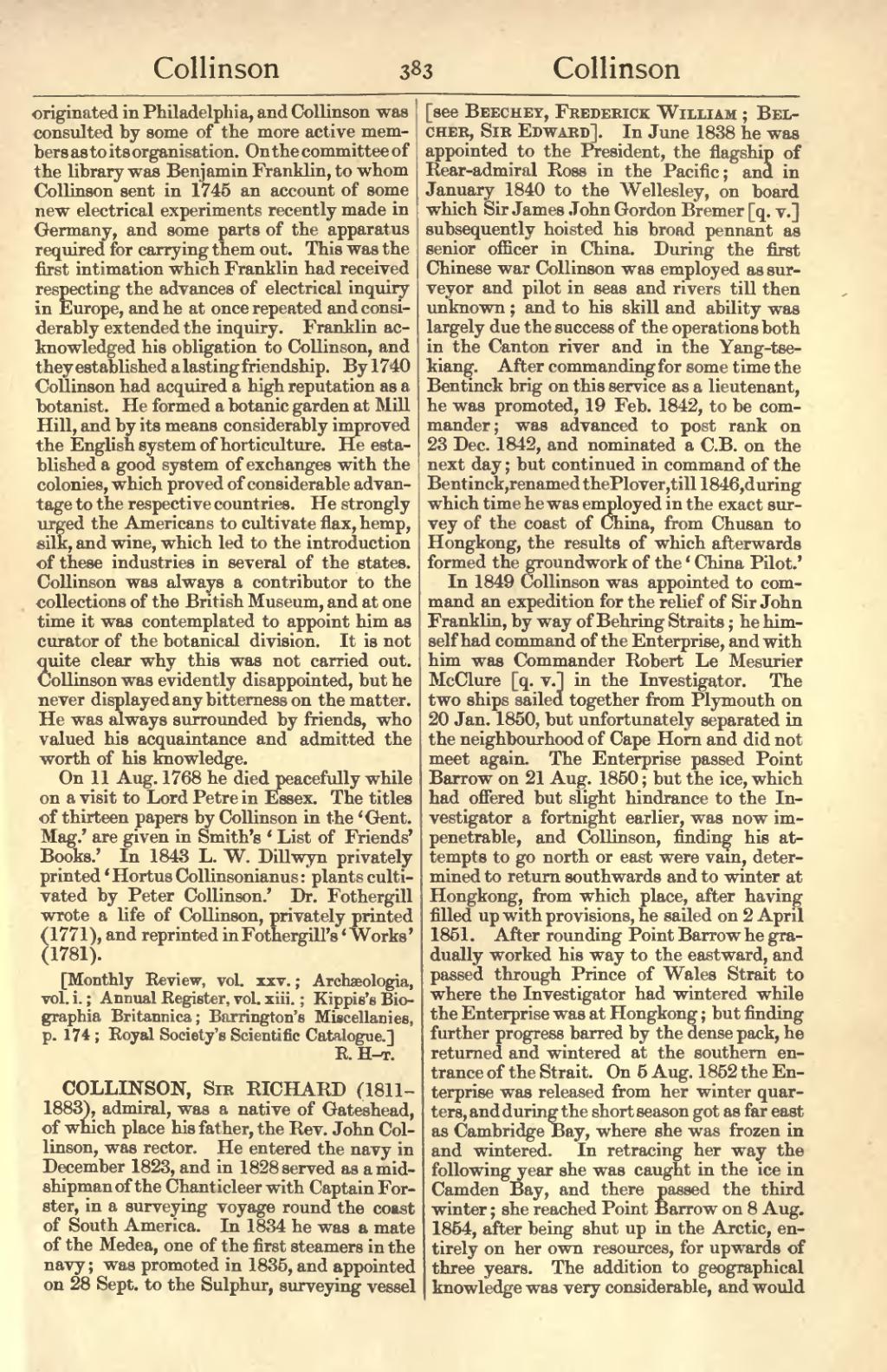originated in Philadelphia, and Collinson was consulted by some of the more active members as to its organisation. On the committee of the library was Benjamin Franklin, to whom Collinson sent in 1745 an account of some new electrical experiments recently made in Germany, and some parts of the apparatus required for carrying them out. This was the first intimation which Franklin had received respecting the advances of electrical inquiry in Europe, and he at once repeated and considerably extended the inquiry. Franklin acknowledged his obligation to Collinson, and they established a lasting friendship. By 1740 Collinson had acquired a high reputation as a botanist. He formed a botanic garden at Mill Hill, and by its means considerably improved the English system of horticulture. He established a good system of exchanges with the colonies, which proved of considerable advantage to the respective countries. He strongly urged the Americans to cultivate flax, hemp, silk, and wine, which led to the introduction of these industries in several of the states. Collinson was always a contributor to the collections of the British Museum, and at one time it was contemplated to appoint him as curator of the botanical division. It is not quite clear why this was not carried out. Collinson was evidently disappointed, but he never displayed any bitterness on the matter. He was always surrounded by friends, who valued his acquaintance and admitted the worth of his knowledge.
On 11 Aug. 1768 he died peacefully while on a visit to Lord Petre in Essex. The titles of thirteen papers by Collinson in the 'Gent. Mag.' are given in Smith's 'List of Friends' Books.' In 1843 L. W. Dillwyn privately printed 'Hortus Collinsonianus: plants cultivated by Peter Collinson.' Dr. Fothergill wrote a life of Collinson, privately printed (1771), and reprinted in Fothergill's 'Works' (1781).
[Monthly Review, vol. xxv.; Archæologia, vol. i.; Annual Register, vol. xiii.; Kippis's Biographia Britannica; Barrington's Miscellanies, p. 174; Royal Society's Scientific Catalogue.]
COLLINSON, Sir RICHARD (1811–1883), admiral, was a native of Gateshead, of which place his father, the Rev. John Collinson, was rector. He entered the navy in December 1823, and in 1828 served as a midshipman of the Chanticleer with Captain Forster, in a surveying voyage round the coast of South America. In 1834 he was a mate of the Medea, one of the first steamers in the navy; was promoted in 1835, and appointed on 28 Sept. to the Sulphur, surveying vessel [see Beechey, Frederick William; Belcher, Sir Edward]. In June 1838 he was appointed to the President, the flagship of Rear-admiral Ross in the Pacific; and in January 1840 to the Wellesley, on board which Sir James John Gordon Bremer [q. v.] subsequently hoisted his broad pennant as senior officer in China. During the first Chinese war Collinson was employed as surveyor and pilot in seas and rivers till then unknown; and to his skill and ability was largely due the success of the operations both in the Canton river and in the Yang-tse-kiang. After commanding for some time the Bentinck brig on this service as a lieutenant, he was promoted, 19 Feb. 1842, to be commander; was advanced to post rank on 23 Dec. 1842, and nominated a C.B. on the next day; but continued in command of the Bentinck, renamed the Plover, till 1846, during which time he was employed in the exact survey of the coast of China, from Chusan to Hongkong, the results of which afterwards formed the groundwork of the 'China Pilot.'
In 1849 Collinson was appointed to command an expedition for the relief of Sir John Franklin, by way of Behring Straits; he himself had command of the Enterprise, and with him was Commander Robert Le Mesurier McClure [q. v.] in the Investigator. The two ships sailed together from Plymouth on 20 Jan. 1850, but unfortunately separated in the neighbourhood of Cape Horn and did not meet again. The Enterprise passed Point Barrow on 21 Aug. 1850; but the ice, which had offered but slight hindrance to the Investigator a fortnight earlier, was now impenetrable, and Collinson, finding his attempts to go north or east were vain, determined to return southwards and to winter at Hongkong, from which place, after having filled up with provisions, he sailed on 2 April 1851. After rounding Point Barrow he gradually worked his way to the eastward, and passed through Prince of Wales Strait to where the Investigator had wintered while the Enterprise was at Hongkong; but finding further progress barred by the dense pack, he returned and wintered at the southern entrance of the Strait. On 5 Aug. 1852 the Enterprise was released from her winter quarters, and during the short season got as far east as Cambridge Bay, where she was frozen in and wintered. In retracing her way the following year she was caught in the ice in Camden Bay, and there passed the third winter; she reached Point Barrow on 8 Aug. 1854, after being shut up in the Arctic, entirely on her own resources, for upwards of three years. The addition to geographical knowledge was very considerable, and would
